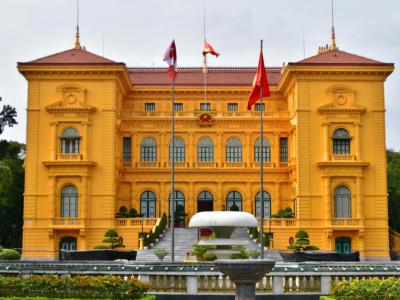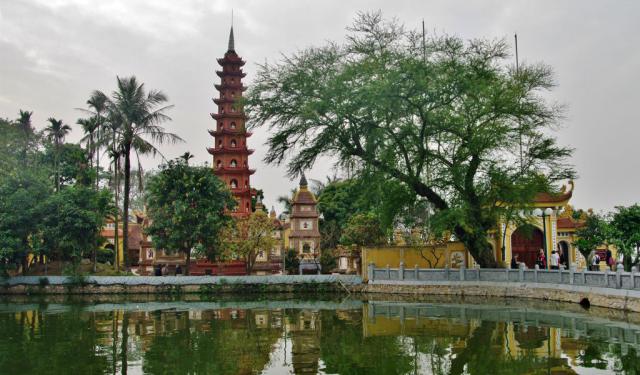
Presidential Palace, Hanoi
The Presidential Palace in Hanoi was built as the residence of the Governor General under French colonial rule. Today it is used as a guest house and reception facility for foreign dignitaries.
The Presidential Palace is a yellow three storey building constructed in Renaissance and Beaux Art style. The French colonial rulers had a civilizing mission and believed that European architectural styles were superior to traditional Asian housing design. The building has no Asian architectural feature. It was built in 1900 by Auguste Henri Vildieu, who was the official architect of Vietnam. The building stands behind strong wrought iron gates with sentry boxes on either side.
The palace is surrounded by expansive grounds including an alley with mango trees that leads to a humble structure on stilts occupied by Ho Chi Minh. After independence, Ho Chi Minh refused to live in the presidential palace and chose to stay in the servant’s quarters till his small cottage was constructed in the grounds. The cottage called uncle Ho’s cottage or the Nha San Bac Ho, is designed like the traditional houses in North West Vietnam that offered shelter to revolutionaries during their struggle for independence from the French rulers.
The presidential palace is off limits to visitors but the grounds and the cottage of Ho Chi Minh can be viewed for a small fee.
The Presidential Palace is a yellow three storey building constructed in Renaissance and Beaux Art style. The French colonial rulers had a civilizing mission and believed that European architectural styles were superior to traditional Asian housing design. The building has no Asian architectural feature. It was built in 1900 by Auguste Henri Vildieu, who was the official architect of Vietnam. The building stands behind strong wrought iron gates with sentry boxes on either side.
The palace is surrounded by expansive grounds including an alley with mango trees that leads to a humble structure on stilts occupied by Ho Chi Minh. After independence, Ho Chi Minh refused to live in the presidential palace and chose to stay in the servant’s quarters till his small cottage was constructed in the grounds. The cottage called uncle Ho’s cottage or the Nha San Bac Ho, is designed like the traditional houses in North West Vietnam that offered shelter to revolutionaries during their struggle for independence from the French rulers.
The presidential palace is off limits to visitors but the grounds and the cottage of Ho Chi Minh can be viewed for a small fee.
Want to visit this sight? Check out these Self-Guided Walking Tours in Hanoi. Alternatively, you can download the mobile app "GPSmyCity: Walks in 1K+ Cities" from Apple App Store or Google Play Store. The app turns your mobile device to a personal tour guide and it works offline, so no data plan is needed when traveling abroad.
Presidential Palace on Map
Sight Name: Presidential Palace
Sight Location: Hanoi, Vietnam (See walking tours in Hanoi)
Sight Type: Attraction/Landmark
Guide(s) Containing This Sight:
Sight Location: Hanoi, Vietnam (See walking tours in Hanoi)
Sight Type: Attraction/Landmark
Guide(s) Containing This Sight:
Walking Tours in Hanoi, Vietnam
Create Your Own Walk in Hanoi
Creating your own self-guided walk in Hanoi is easy and fun. Choose the city attractions that you want to see and a walk route map will be created just for you. You can even set your hotel as the start point of the walk.
Hanoi Introduction Walking Tour
Known for its centuries-old architecture and rich culture with Southeast Asian, Chinese and French influences, the capital of Vietnam, Hanoi, traces its origin back to the third century BC. Originally, a portion of modern-day Hanoi served as the capital of the historic Vietnamese nation Âu Lạc. Following the collapse of Âu Lạc, the city was made part of Han China (111 BC-40 AD).
... view more
Tour Duration: 2 Hour(s)
Travel Distance: 4.0 Km or 2.5 Miles
... view more
Tour Duration: 2 Hour(s)
Travel Distance: 4.0 Km or 2.5 Miles
Hanoi's Old Quarter Walking Tour
The Old Quarter (Vietnamese: Phố cổ Hà Nội) is the name commonly given to the historical civic urban core of the city, located outside the Imperial Citadel of Thăng Long in the northern half of Hoàn Kiếm District, renowned for its small street blocks and alleys, and a traditional Vietnamese atmosphere.
During the Lê dynasty (1428-1789), the area included several lakes and wetlands... view more
Tour Duration: 2 Hour(s)
Travel Distance: 4.0 Km or 2.5 Miles
During the Lê dynasty (1428-1789), the area included several lakes and wetlands... view more
Tour Duration: 2 Hour(s)
Travel Distance: 4.0 Km or 2.5 Miles


